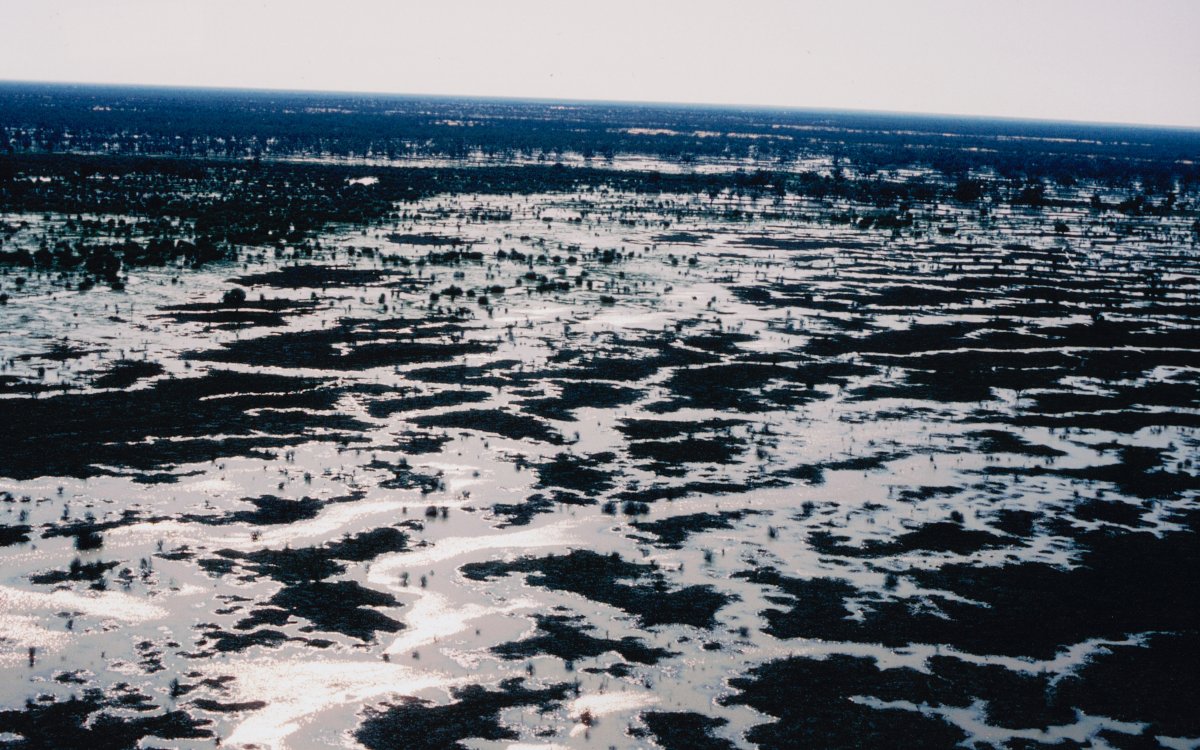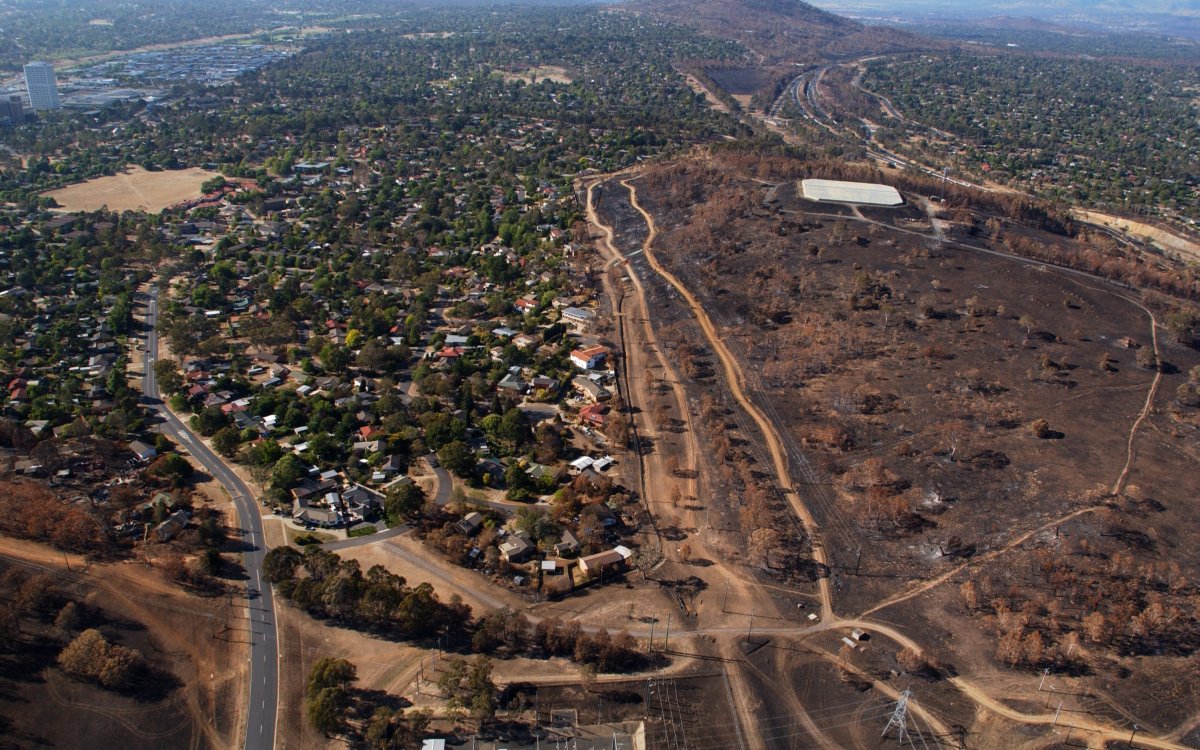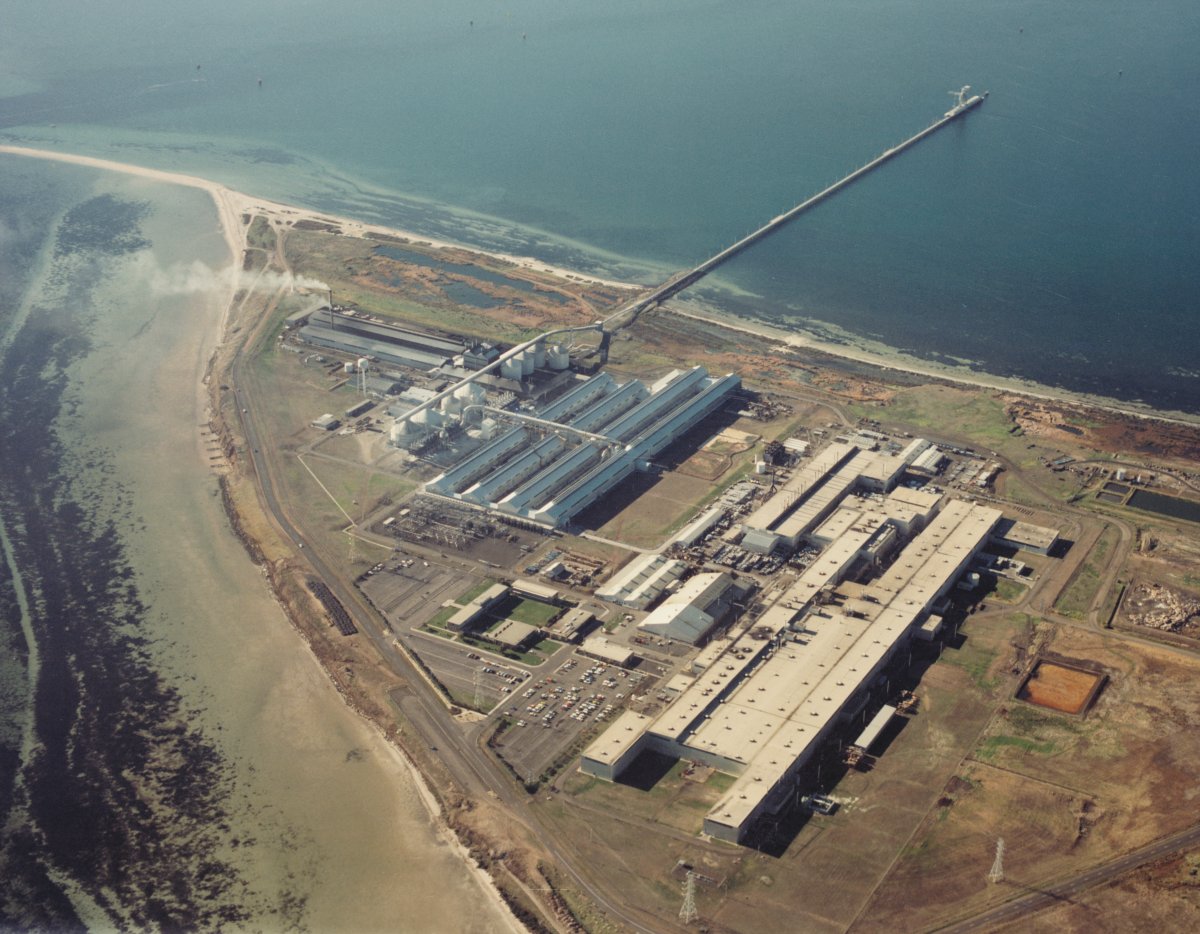The Earth and its environments are constantly changing. For millions of years, the wind has shaped and eroded mountains and sand dunes; the constant crashing of waves has changed and sculpted the coastline; and drought and fire have charred and renewed bushland. This process is ongoing and is a natural part of life.
Fire
Fire is a destructive element that sweeps through a landscape with no regard to the property, flora or fauna present. Australia has a long history of raging bushfires that have left vast areas of bush and grasslands blackened; however, while destructive and brutal, fire holds the key to regeneration for many species of Australian plants and trees and revitalises ecosystems that have adapted to cope with fire damage. Fire clears fallen leaves and branches from the bushland floor, reducing competition for seedlings and smaller plants. Trees and branches that fall and die because of the fire can provide habitats for animals. In addition, not all plant species meet their end in a bushfire. Many species of Australian plants require the intense heat of a bushfire for them to germinate and reproduce. These plants drop seeds that lie dormant in the soil until the heat of the flames and the smoke in the air begins a chemical reaction that begins the seeds’ life cycles. Some plants actively encourage bushfires. Many eucalyptus species are fire-tolerant, meaning that while they sustain damage from fire, they can continue to grow. They produce flammable oils, which can help fires spread quicker. This mechanism is an attempt to remove other less fire-tolerant plants from competing for their food and water in the same area.
Australia’s First Nations peoples have used fire management to care for the environment for millennia. You can read more about this process of land management in the Year 9 Digital Classroom ‘The Use and Influence of Science’. Many scientists and traditional landowners have promoted the benefits of using traditional fire management methods to prevent or mitigate the impact of large-scale bushfires, especially in regions close to human settlement or of ecological significance. More information can also be found on the Australia Curriculum: Teacher background information page.

Cutting, Jeff, 1945-. (2003). Menace in the mountains, smoke from the Stockyard Spur, Mount Gingera, Bendora, and McIntyre's Hut fires drifting away from Canberra on 13 January 2003 failed to alert the population to the coming conflagration [picture] / by Jeff Cutting. http://nla.gov.au/nla.obj-149607014

Cutting, Jeff, 1945-. (2003). Portent to a disaster, the immense convection column over the Stockyard fire breaking eastwards into Namadgi National Park as a blow up fire, dusk 17 January 2003 [picture] / Jeff Cutting. http://nla.gov.au/nla.obj-149583070

Cutting, Jeff, 1945-. (2003). Freshening north-westerly winds drove the Stockyard fire down Apollo Road onto Ballineen in the hour before midnight on 17th January 2003. [picture] / Jeff Cutting. http://nla.gov.au/nla.obj-149584789

Cutting, Jeff, 1945-. (2003). The heel of the Bendora fire burning in mixed Alpine Ash and Mountain Gum forest on Bendora Hill at dusk, Wednesday 8th January 2003 picture] / Jeff Cutting. http://nla.gov.au/nla.obj-149591291

Davey, Sean, 1979-. (2019). Aftermath of a large bushfire that swept through forest area along Yowrie Road, Yowrie, New South Wales, 31 December 2019 / Sean Davey. https://nla.gov.au/nla.obj-2428728997
Flood
Australia has a long history of widespread flooding, with river systems breaking banks and overflowing into the surrounding areas. In some locations, this is an event anticipated by many; for example, the filling of Lake Eyre in South Australia, which fills to capacity only a few times a century. When the lake is filled, birds from thousands of kilometres around flock to its shores to feed. However, in other locations, floods cause destruction and havoc, sweeping away trees, houses and infrastructure. Floodwater can carry enormous amounts of heavy debris along with the flow, causing additional damage to the landscape along the way. Floodwater claims the lives of countless animals who can’t escape to higher ground and, sadly, humans too are sometimes killed when flood waters rise.

McKay, Andrew Leslie, 1909-1976. (1973). Flood on the Diamantina crossing at Birdsville, Queensland, ca. 1973, 1 [transparency] / Les McKay. http://nla.gov.au/nla.obj-149840515

Taylor, Peter, 1936-. (1983). Channel country in south-west Queensland in flood, Nappa Merrie Station, Cooper Creek, August 1983 [picture] / [Peter Taylor]. https://nla.gov.au/nla.obj-147618690

Searle, E. W. (Edward William) 1887-1955. (1949). Flood at South Creek, Hawkesbury River, New South Wales, 1949, 1 [picture] / E.W. Searle. http://nla.gov.au/nla.obj-142143997
Floodwater is turbulent and is often muddy brown or black. The force of the water carries away millions of tonnes of dirt, silt and rock and sweeps it along until the water subsides. When the water recedes, mud and soil is deposited and left behind. For humans, this mud can destroy houses, cars and belongings. For animals, this mud fills burrows and homes and can make it impossible to find food for some time. However, for vegetation this mud can be beneficial. Seeds and plant spores can survive the turbulent waters and are dropped along the path of the flood. The organic material deposited by the flood waters brings nutrients that enrich the soil, providing food for new plant growth. Floodwater can also replenish water resources such as dry creeks, dams and lakes. With water sources renewed, mass animal breeding events can be triggered.
Drought
Australia has an enduring reputation as the desert continent, with red sands and dusty plains. While this is true of large areas of the interior and western coast, Australia’s east coast is home to dense rainforests in Far North Queensland; while through New South Wales the landscape becomes rolling green hills and pastures; and into Victoria extend the snow-topped mountains of the Great Dividing Range, where rivers rise and flow into the enormous Murray–Darling Basin. Australia’s eastern seaboard receives most of the continent’s regular rainfall. The wettest areas are around Cairns in Queensland and along Tasmania’s west coast, with Tasmania also holding the record for the most frequent rain, an average of 237 days a year.
Australia’s inland regions are classed as arid and semi-arid biomes. These climate zones tend to be hot and dry all year round. Marble Bar in Western Australia holds the record for the highest average monthly temperature, reaching an average monthly temperature in December of 41.5° Celsius, and Lake Eyre in South Australia holds the record for the driest area in the country, with only 125 mm of rain per year, on average. These regions can be inhospitable to humans if they are unprepared for the conditions and unfamiliar with the landscape; however, Australia’s First Nations peoples have called the central deserts of Australia home for thousands of years and today towns and settlements dot the continent’s interior. The plants and animals that make their home in the arid areas of the country have adapted to live and thrive in the harsh conditions.

Chapman, Andrew, 1954-. (2020). Drought effected lower Darling River Basin, north of Pooncarie, New South Wales, March 2020 / Andrew Chapman. https://nla.gov.au/nla.obj-2702945375

Chapman, Andrew, 1954-. (2020). Effects of the drought along Pooncarie Road at Tolarno Station, Menindee, New South Wales, March 2020 / Andrew Chapman. https://nla.gov.au/nla.obj-2702945298

O'Dwyer, Simon, 1969-. (1996). Bridge drought [picture] / Simon O'Dwyer. http://nla.gov.au/nla.obj-149334438

Carter, Jeff, 1928-2010. (2007). Cattle grazing drought pasture on irrigation channel near Finley, New South Wales, February 2007 [picture] / Jeff Carter. http://nla.gov.au/nla.obj-137289419

Clark, Darren, 1967-. (2002). Dry river bed with fish skeleton, Coonamble, New South Wales, 2002 [picture] / Darren Clark. http://nla.gov.au/nla.obj-137030906

Seselja, Loui, 1948- & Crome, E. A. (Ernest Alfred), 1902-1987. (2005). Aerial view of drought affected fields ploughed in response to predictions of rain, 9 June 2005, taken from Air Link Airlines' Beechcraft 1900 D, VH-RUE, Flight DR 743 from Sydney to Dubbo [picture] / Loui Seselja. https://nla.gov.au/nla.obj-131240094
When rain has not fallen for a prolonged period, this is called drought. Drought can be a natural cycle in some parts of the world. These places experience long hot seasons where no rain falls. Drought is then broken by a wet season of monsoonal rains that replenish water supplies and trigger natural cycles. Drought can have detrimental effects on an ecosystem when it is extended due to changing or disrupted weather patterns, or if the ecosystem is not equipped to tolerate prolonged dry spells. Animals that rely on the wet season to feed and reproduce begin to use up their backup stores of food and body fat to survive. Animals will also look further from their homes to find food and water. As they move further out of their natural habitat to search for food and water, they can encounter hazards that are unfamiliar to them, such as hostile terrain, predators and even roads and traffic.
Human activity
Changing climates and disasters such as flood and drought are natural events that happen, often in a pattern. For thousands of years, people across the world have relied on predictable changes in temperature and seasons to plant crops, move campsites and perform important cultural ceremonies. However, natural disasters, destructive weather and irregular climate patterns are growing in frequency and severity across the globe. Human activity has been identified by scientists and climate experts as playing a significant role in these changes. Human activity, both direct and indirect, has been cited as the cause of unnatural levels and speed of global climate change. From the chemical output of cars, factories and industrial processes to widespread clearing of forests, grazing of cattle and the spread of urban settlements, natural weather cycles are increasingly unable to act normally. As the weather patterns become more unstable, temperatures rise on a global scale. With increasing frequency, parts of Australia are experiencing successive seasons of catastrophic weather, where historically they may experience such events only every 50 or 100 years.

Wallace, Robert James, 1967-. (2003). Traffic on General Holmes Drive enters the tunnel beneath the north-south runway at Sydney (Kingsford Smith) Airport while a British Airways 747 taxis out to depart [picture] / Robert James Wallace. http://nla.gov.au/nla.obj-137206280

Sievers, Wolfgang, 1913-2007. (1979). Australian Glass Manufacturers with Westgate Bridge and city of Melbourne in background, [Victoria], 1979 [picture] / Wolfgang Sievers. http://nla.gov.au/nla.obj-160330823

Sievers, Wolfgang, 1913-2007. (1974). Aerial view of Alcoa Point Henry works near Geelong, Victoria, 1974 [picture] / Wolfgang Sievers. http://nla.gov.au/nla.obj-160303269

Flynn, John, 1880-1951. (1912). Cattle grazing, Queensland [transparency] / [John Flynn?]. http://nla.gov.au/nla.obj-142516564
Locations that have usually stable and steady dry–wet cycles of weather are experiencing longer and more severe droughts and dry spells. Plants and animals who are not adapted to survive in these extreme conditions find it difficult to thrive. Animals can succumb to hot temperatures or heatstroke, just as people can, if they cannot find shelter or enough water. When the soil is not used to these conditions, it can leave the ground and foliage dry, dusty and susceptible to fire. If bushfires start, they burn longer, hotter and spread further. According to the Commonwealth Scientific and Industrial Research Organisation (CSIRO), climate change doesn’t cause fires directly but has caused an increase in the occurrence of extreme fire weather and in the length of the fire season across large parts of Australia since the 1950s.

Power, Greg, 1974-. (2003). [Aerial view of areas damaged during the Canberra bushfires in January 2003] [picture] / Greg Power. https://nla.gov.au/nla.obj-130778637

Power, Greg, 1974-. (2003). [Lyons electrical sub-station lower centre, Weston (top right) and Mount Taylor, Canberra, January 2003] [picture] / Greg Power. https://nla.gov.au/nla.obj-130777736

McDonald, Damian, 1971-. (2003). [Damaged playground facility in Duffy, Canberra bushfires, 18 January 2003] [picture] / Damian McDonald. https://nla.gov.au/nla.obj-130737190
On the other hand, when repeated abnormally wet cycles of weather occur, soil can become oversaturated with moisture. Once the soil has absorbed all the water it can, additional water has nowhere to go, so will accumulate on the surface. If the wet conditions continue and the surface water has not had a chance to drain away, water levels will begin to rise and can lead to damaging flooding.

Dekker, Rodney, 1974-. (2007). Tim, a Gippsland Lakes Yacht Club worker, rowing a dingy in front of the flooded club house adjacent to the Esplanade, Gippsland, Victoria, 2007 [picture] / Rodney Dekker. http://nla.gov.au/nla.obj-137352208

Dekker, Rodney, 1974-. (2007). A local resident standing in front of her flooded house, Paynesville, Victoria, 2007 [picture] / Rodney Dekker. http://nla.gov.au/nla.obj-137352365

Dekker, Rodney, 1974-. (2007). Henry Winnett, manager of Ripplewood Caravan Park, begins cleaning up after the flood deposited silt within dwellings, Mitchell River, via Wuk Wuk, Lindenow, Victoria, 2007 [picture] / Rodney Dekker. http://nla.gov.au/nla.obj-137352521
Activities
- Using Trove newspaper search, find articles relating to your town and any historical natural disasters it has faced. What was the experience of the town during this event? Alternatively, have students ask their parents, grandparents or an older person in their life if they remember any such events from their childhood. What was it like during this time?
- Bushfires are a part of life for many parts of Australia; however, in recent times there has been an increase in frequency, length, severity and early arrival of the fire season. Even areas that are not usually prone to large fires find themselves increasingly under threat.
- As a class, brainstorm how students and their families can be prepared for fire (or any natural disaster, as appropriate). Encourage students to discuss this with parents and caregivers at home. What do they need to have ready to go? What can they do to protect their house? Where do they find reliable information in the event of a disaster?
- As a class, brainstorm how students and their families can be prepared for fire (or any natural disaster, as appropriate). Encourage students to discuss this with parents and caregivers at home. What do they need to have ready to go? What can they do to protect their house? Where do they find reliable information in the event of a disaster?
- The growth of human industry has increased since the Industrial Revolution, with factories, cars, machinery and urbanisation reaping resources from land that was once habitat for plants and animals.
- Using Trove, find historical maps of your region, plot the expansion of the town over several decades or more, as the maps allow. As a class, discuss what this has meant for the environment and the ecology of the region.
More information and activities can be found on the Australian Government National Recovery and Resilience Agency website.























